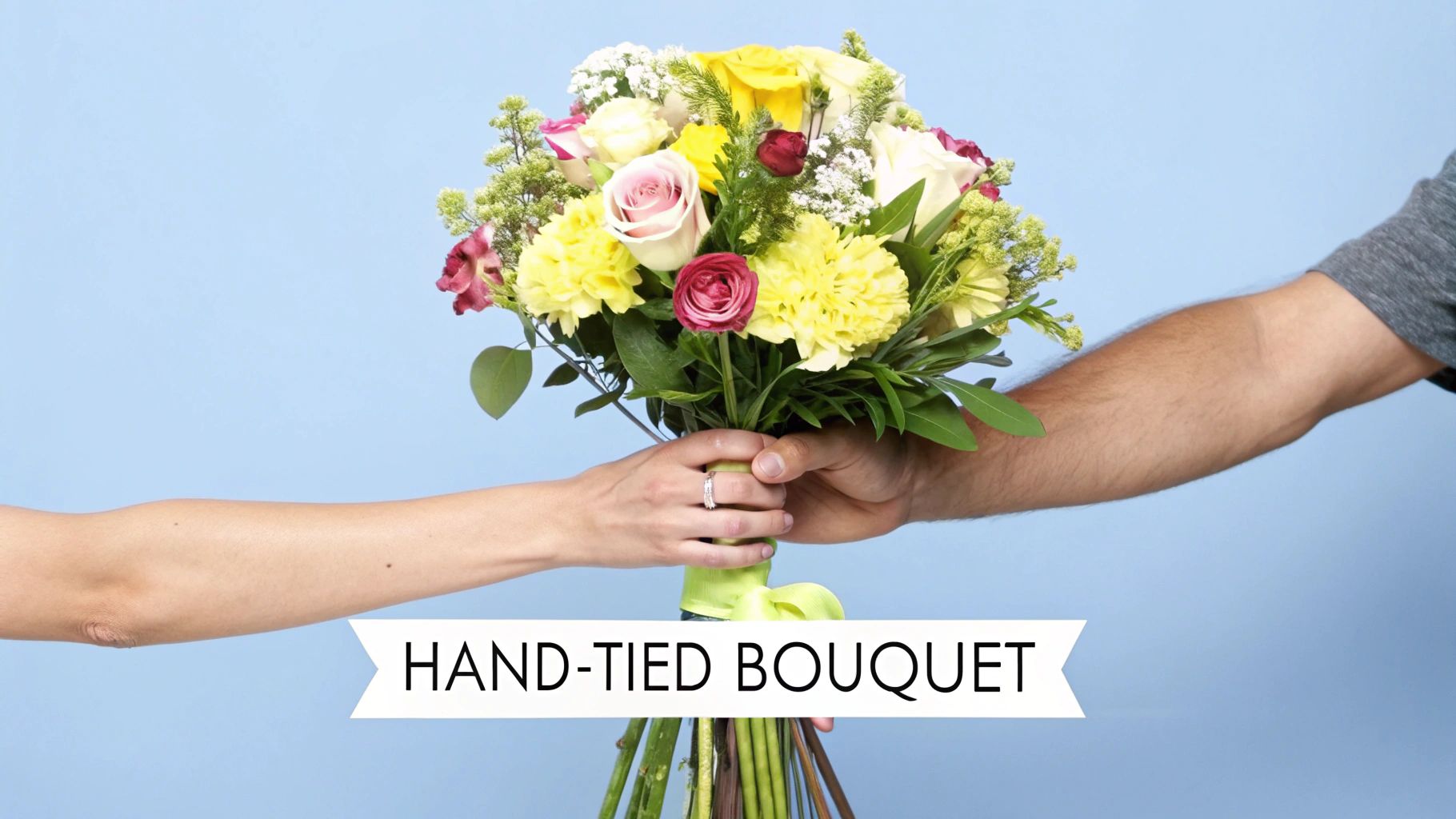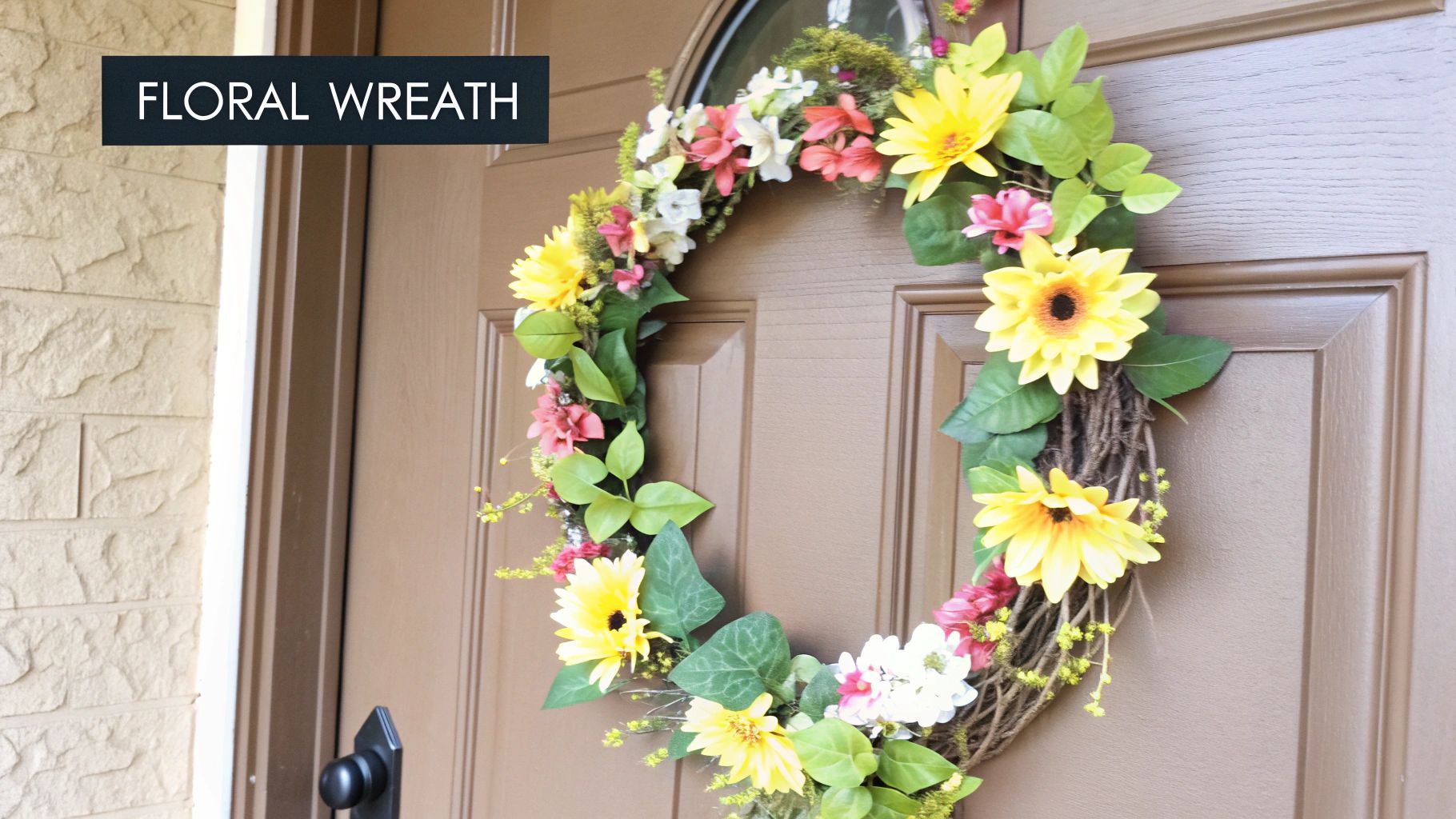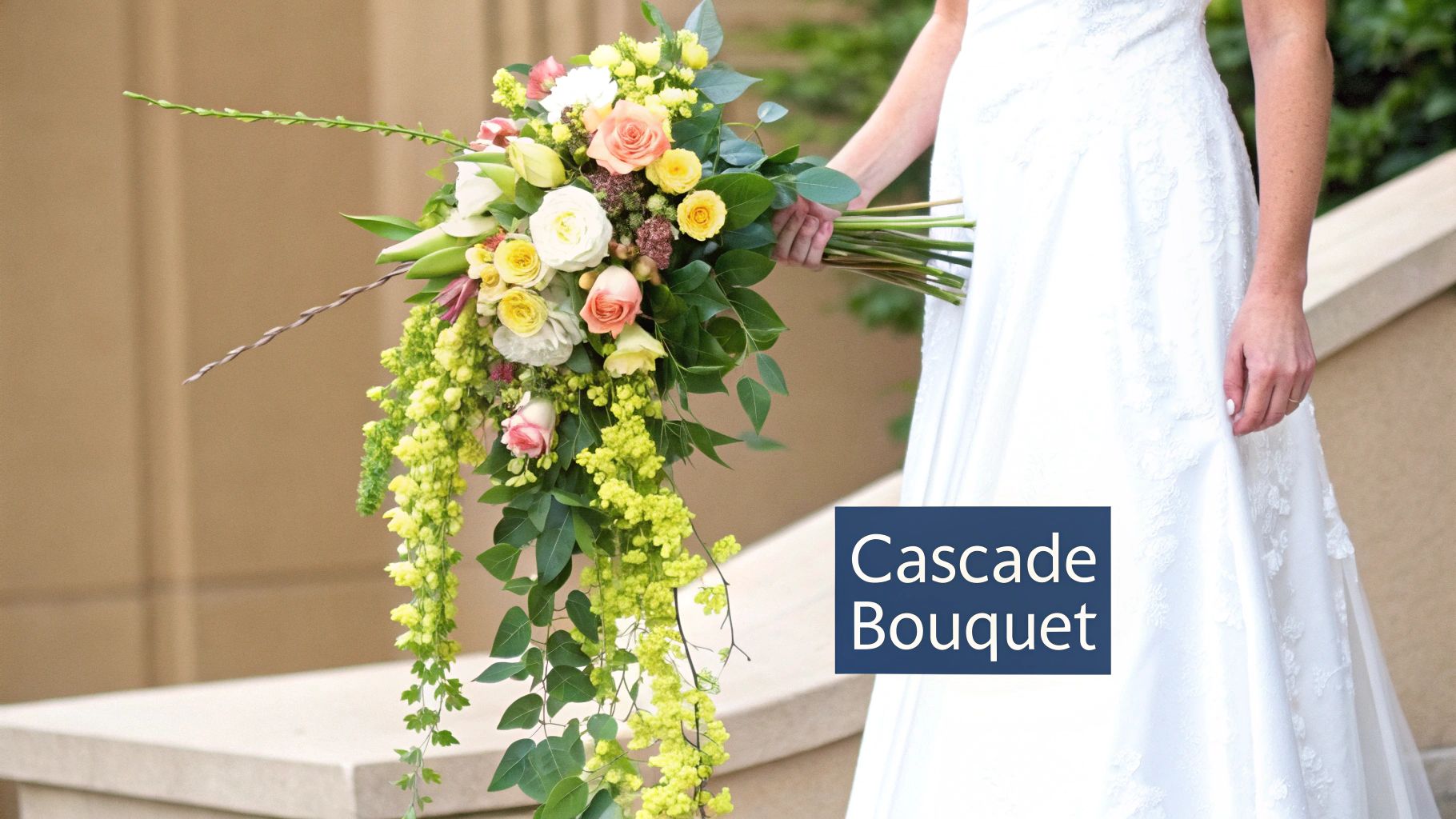
9 Types of Flower Arrangements to Know in 2025
Share
Flowers communicate a universal message, but the way they are arranged gives them a distinct and powerful voice. Selecting the right floral design is crucial, whether you are planning a milestone event, sending a thoughtful gift, or simply adding a touch of natural beauty to your space. Understanding the core principles behind different types of flower arrangements empowers you to move beyond generic choices and select a style that perfectly captures your intended sentiment and aesthetic.
This comprehensive guide is designed to be your definitive resource, moving past simple descriptions to offer practical, actionable insights. We will deconstruct nine essential arrangement styles, from the classic hand-tied bouquet and elegant centerpiece to the minimalist art of Ikebana and the dramatic cascade. For each type, you will discover its defining characteristics, ideal applications, and specific design tips to help you create or commission the perfect floral statement.
You will learn to identify which arrangements suit grand wedding celebrations, which are best for intimate anniversary dinners, and which can transform a corporate space or offer a heartfelt message of sympathy. By the end of this article, you will have the knowledge to confidently choose and discuss floral designs, ensuring every petal and stem works together to convey your exact message with precision and style.
1. Bouquet
Among all the different types of flower arrangements, the bouquet is arguably the most iconic and versatile. It is a hand-held collection of cut flowers, foliage, and other botanical elements artfully gathered and bound together at the stems. Its portability and personal nature make it a go-to choice for gifting and ceremonies, where the arrangement is meant to be carried or presented directly to the recipient.

From structured bridal bouquets popularized by royal weddings to the more relaxed, hand-tied bunches perfect for a "just because" gift, the bouquet's form is highly adaptable. This adaptability allows it to convey a wide range of emotions and suit countless occasions.
Ideal Occasions & Design Tips
A bouquet is the perfect choice for personal gestures where direct presentation is key.
- Best For: Weddings (bridal and bridesmaid bouquets), anniversaries, Valentine's Day, Mother's Day, and sympathy tributes.
- Design Tip: For a visually pleasing and balanced look, professional florists often use an odd number of focal flowers (e.g., three, five, or seven roses). This creates a more natural, less symmetrical appearance that is engaging to the eye.
- Pro Tip: To maximize freshness, trim about an inch off the stems at a 45-degree angle under running water before placing them in a vase. This increases the surface area for water absorption and prevents air bubbles from blocking the stems.
For those interested in creating their own, mastering the fundamental techniques is key. You can find more details in this guide to making a bouquet on budweismiller.com.
2. Centerpiece
A centerpiece is a decorative floral arrangement specifically designed to be a focal point, typically placed in the middle of a dining table, conference table, or as a central feature in a room. Unlike a bouquet, a centerpiece is created within a container and is designed to be viewed from all sides, making it a cornerstone of event and home decor. These arrangements are usually low and wide, ensuring they enhance the atmosphere without obstructing views or conversation.

From elegant wedding reception tables to festive holiday dinner settings, the centerpiece sets the tone for the entire event. Premier event planners and high-end restaurants often leverage sophisticated centerpieces, sometimes incorporating elements like candles, fruit, or other decorative objects to create a complete tablescape. This makes it one of the most impactful types of flower arrangements for creating an immersive environment.
Ideal Occasions & Design Tips
A centerpiece is the perfect choice for any occasion that involves a gathering around a table, transforming a simple surface into a stunning visual anchor.
- Best For: Wedding receptions, holiday dinners (Thanksgiving, Christmas), corporate events and galas, formal dinner parties, and restaurant table decor.
- Design Tip: When creating a centerpiece for a dining table, a key rule is to keep the arrangement under 12 inches tall. This "low-profile" design ensures guests can easily see and converse with each other across the table without obstruction.
- Pro Tip: Use floral foam saturated in water and placed within a waterproof container as your base. This provides a stable structure, a continuous water source for the flowers, and allows you to precisely control the placement and angle of each stem for a 360-degree design.
3. Corsage and Boutonniere
Among the various types of flower arrangements, corsages and boutonnieres are unique for being wearable art. These small, intricate designs serve as personal floral accessories, symbolizing honor, celebration, and formal recognition. A corsage is typically a larger piece worn by women, either pinned to a dress or worn on the wrist, while a boutonniere is a smaller, complementary design worn by men on a suit lapel.

These arrangements are deeply rooted in tradition, tracing back to Victorian formal wear customs and now heavily popularized by American prom traditions and wedding industry standards. Their purpose is to signify a special role or connection, making them essential for milestone events where individuals are being honored or celebrated.
Ideal Occasions & Design Tips
Corsages and boutonnieres are perfect for formal events where a touch of floral elegance is desired to complete an outfit.
- Best For: Proms, homecomings, weddings (for the wedding party and key family members), formal dances, and Mother's Day celebrations.
- Design Tip: When selecting flowers, consider the wearer's outfit. The blooms should complement the colors and style of the attire without overwhelming it. Choose a hardy focal flower, like a rose or orchid, that will withstand movement and remain fresh.
- Pro Tip: To ensure longevity, these delicate arrangements should be kept refrigerated in a sealed container until just before the event. A light misting of water can also help keep the petals hydrated and vibrant throughout the occasion.
These small arrangements carry significant meaning and require careful construction. For inspiration, explore these examples of boutonnieres created by budweismiller.com.
4. Wreath
The wreath is a powerful and symbolic entry among the different types of flower arrangements, representing eternity, unity, and the cyclical nature of life. It is a circular arrangement of flowers, foliage, twigs, and other decorative elements built upon a sturdy frame. This timeless design is not confined to a single purpose; it serves as a welcoming beacon on a front door, a solemn tribute at a memorial, or a festive centerpiece during seasonal celebrations.

Popularized through ancient Greek and Roman traditions and later integrated into Christian holiday customs, the wreath's enduring appeal has been cemented by modern home decor influencers like Martha Stewart. Its versatility allows it to be adapted for any season or event, from lush, green Christmas wreaths to delicate, pastel spring designs.
Ideal Occasions & Design Tips
A wreath is an excellent choice for decorative displays and commemorative gestures where its symbolism can add deeper meaning.
- Best For: Christmas and holiday door decor, funeral and memorial services, harvest festivals, seasonal home decorating (e.g., spring or autumn wreaths), and commemorative events.
- Design Tip: When creating a wreath, always start with a sturdy base, such as a wireframe, grapevine, or foam ring. Layer your materials strategically, beginning with the fullest foliage at the back and working your way forward with finer textures and focal flowers.
- Pro Tip: Secure each element tightly to the frame using flexible floral wire, wrapping it around the stems and the base. To keep a fresh wreath vibrant longer, especially one made with fresh-cut greens and flowers, mist it with water every one to two days.
5. Ikebana
Far more than just putting flowers in a vase, Ikebana is the revered Japanese art of flower arrangement, a disciplined practice that treats floral design as a spiritual endeavor. Unlike Western arrangements that often prioritize mass and color, Ikebana emphasizes minimalism, line, form, and the empty space between elements. This approach aims to create a harmonious balance between the materials, the container, and the setting, reflecting a deep appreciation for nature's quiet beauty.
Pioneered by masters like Ikenobo Sen'no, this art form uses a minimal number of stems to create maximum impact. The structure often represents the connection between heaven, earth, and humanity, making it one of the most contemplative and profound types of flower arrangements available. Its deliberate, sculptural quality makes it a stunning addition to modern and minimalist interiors.
Ideal Occasions & Design Tips
Ikebana is best suited for spaces where it can be appreciated as a piece of living art.
- Best For: Modern home decor, Zen gardens, art gallery installations, corporate lobbies, and traditional tea ceremonies.
- Design Tip: Most Ikebana schools, including Ikenobo, Ohara, and Sogetsu, are built upon a foundational principle of an asymmetrical triangle. This structure, known as shin, soe, and hikae, represents heaven, man, and earth, creating a dynamic yet balanced composition.
- Pro Tip: In Ikebana, the container (utsuwa) is not just a vessel; it is an integral part of the overall design. Choose a vase or dish that complements the lines and textures of your plant materials, and consider its color and form as part of the arrangement's story.
For those looking to explore this ancient art, starting with a single flower and a branch is an excellent way to practice appreciating form and space. You can learn more about its philosophy from this introduction to the spirit of Ikebana at ikebanahq.org.
6. Garland
A garland is a beautiful and flowing example of the different types of flower arrangements, created by weaving or wiring flowers, foliage, and other botanical elements into a long, decorative strand. Unlike contained arrangements, garlands are designed to drape, hang, or encircle, making them ideal for adding a touch of natural elegance to architecture, entryways, or even as personal adornment. Their continuous, rope-like form offers a unique way to frame a space or highlight a specific feature.
From the fragrant marigold garlands used in Indian wedding ceremonies to the lush evergreen strands that adorn mantels during the holidays, this arrangement style is steeped in tradition and celebration. Its versatility allows it to be simple and rustic or incredibly elaborate and formal, depending on the choice of flowers and foliage.
Ideal Occasions & Design Tips
Garlands are perfect for large-scale decorations and adding a festive, organic feel to any environment.
- Best For: Wedding arches and tablescapes, holiday decorations (mantels, staircases), festival decor, and ceremonial events like graduations or religious celebrations.
- Design Tip: For easier construction and installation, build your garland in smaller, more manageable sections. You can then connect these sections on-site, which also simplifies transportation and helps maintain the arrangement's freshness.
- Pro Tip: Pay close attention to weight distribution, especially for hanging garlands. Use a strong base like thick twine or floral wire and balance heavier elements (like dense blooms or fruit) evenly along the length to prevent sagging or breaking. Misting the finished garland with water will help keep it looking vibrant, especially if it's made a day in advance.
7. Topiary
Bridging the gap between horticulture and floral artistry, the topiary is one of the most sculptural types of flower arrangements. It involves training and trimming living plants or arranging cut flowers and foliage on a frame to create distinct geometric or whimsical shapes. This technique transforms flowers from a simple collection into a living sculpture, offering a unique and commanding visual impact.
Popularized by the formal gardens of Europe and now a staple in high-end event design and even Disney theme parks, floral topiaries are statement pieces. They can be crafted into spheres, cones, animals, or even company logos, making them incredibly versatile for decorative purposes where a strong focal point is needed.
Ideal Occasions & Design Tips
A topiary is perfect for creating an atmosphere of formal elegance or playful creativity, guiding the eye and defining a space.
- Best For: Grand wedding ceremony entrances, elegant hotel lobbies, sophisticated garden parties, and corporate events seeking branded decor.
- Design Tip: For DIY projects, start with a simple geometric shape like a sphere or cone. Use a sturdy base and a wire or floral foam frame to ensure the structure is secure and won't tip over. Soak floral foam thoroughly before inserting stems.
- Pro Tip: Choose flowers and foliage with strong, woody stems that can be easily inserted into the foam and will hold their shape. Roses, carnations, chrysanthemums, and boxwood are excellent choices that provide both durability and dense coverage.
8. Cascade/Waterfall Arrangement
The cascade, or waterfall arrangement, is one of the most dramatic and elegant types of flower arrangements, designed to mimic the flowing movement of water. In this style, flowers and foliage are arranged to spill gracefully downwards from a central point, creating a stunning vertical line that draws the eye from top to bottom. Its lavish, trailing appearance makes it a statement piece, synonymous with high-end events and grand romantic gestures.
Popularized during the Victorian era and famously featured in royal weddings, including that of Princess Diana, the cascade bouquet remains a symbol of sophisticated, timeless beauty. This arrangement style is not just for bouquets; it is frequently used for large-scale installations like altar arrangements in churches, hotel lobby centerpieces, and backdrops for award ceremonies.
Ideal Occasions & Design Tips
A cascade arrangement is perfect for formal settings where you want to create a sense of grandeur and opulence.
- Best For: Weddings (especially bridal bouquets), formal award ceremonies, church altars, and large-scale venue decorations.
- Design Tip: Create a strong, secure foundation using a holder with floral foam and potentially wire supports. Begin by establishing the cascading shape with your longest trailing foliage and vines, then fill in the structure with focal flowers, working from the top down to ensure a balanced and harmonious flow.
- Pro Tip: Pay close attention to weight distribution. A cascade arrangement can become heavy and unbalanced quickly. Secure heavier blooms closer to the base or holder and use lighter, more delicate flowers and foliage for the extended trailing sections to maintain structural integrity and a graceful appearance.
9. Pressed Flower Art
Shifting from three-dimensional designs to a two-dimensional medium, pressed flower art is one of the most unique types of flower arrangements. This technique involves carefully drying and flattening flowers and foliage under pressure, preserving their delicate form and color. The resulting botanical specimens are used to create permanent artistic compositions that can be framed, embedded in resin, or used in crafts.
Popularized by Victorian-era botanical enthusiasts and scientific collectors, this method offers a timeless way to capture the ephemeral beauty of a specific moment or bloom. It transforms a fleeting floral gift into a lasting piece of decor, making it perfect for preserving sentimental flowers from a special occasion.
Ideal Occasions & Design Tips
Pressed flower art is the ultimate choice for preserving memories and creating heirloom-quality pieces.
- Best For: Preserving wedding bouquets, creating framed botanical art, decorating greeting cards and stationery, and crafting unique jewelry or home decor.
- Design Tip: For the best results, press flowers when they are fresh and completely dry from any morning dew or rain. Moisture can lead to mold during the pressing process. Choose blooms that are naturally flat, like pansies, violets, and cosmos, as they press more easily than thick, dense flowers.
- Pro Tip: To prevent fading, store or display your finished pressed flower art away from direct sunlight and high humidity. UV-protective glass for framed pieces can significantly prolong the vibrancy of the colors.
This technique allows you to hold onto the memories attached to a special floral arrangement forever. You can explore professional options by reviewing this guide to flower pressing and preservation services on budweismiller.com.
Types of Flower Arrangements Comparison Table
| Item | Implementation Complexity | Resource Requirements | Expected Outcomes | Ideal Use Cases | Key Advantages |
|---|---|---|---|---|---|
| Bouquet | Low to moderate | Moderate (flowers, binding tools) | Portable, versatile arrangements | Weddings, personal gifts, ceremonies | Highly portable, cost-effective, versatile |
| Centerpiece | Moderate | Moderate to high (flowers, containers) | Focal decorative arrangement for tables | Receptions, dinners, corporate events | Ambiance creation, unobtrusive, customizable |
| Corsage and Boutonniere | Low | Low (small flowers, pins, tape) | Wearable floral accents | Proms, weddings, formal events | Adds elegance, affordable, symbolic |
| Wreath | Moderate to high | Moderate (frame, flowers, wire) | Circular decorative display, often outdoor | Holidays, memorials, seasonal decor | Long-lasting, versatile, suitable outdoors |
| Ikebana | High | Low to moderate (minimal flowers, containers) | Artistic, meditative floral art | Tea ceremonies, minimalist décor, galleries | Promotes harmony, cost-effective, artistic |
| Garland | Moderate to high | Moderate to high (wire, flowers) | Flexible, continuous strand decoration | Ceremonies, large decorations, festivals | Dramatic, versatile, covers large areas |
| Topiary | High | High (frames, flowers/plants) | Sculptural, shaped floral displays | Formal events, lobbies, themed parties | Unique, customizable, eye-catching |
| Cascade/Waterfall Arrangement | High | High (flowers, foam, wire) | Flowing, dramatic vertical arrangement | Formal weddings, ceremonies, photo ops | Dramatic impact, elegant, vertical use |
| Pressed Flower Art | Moderate | Low (flowers, pressing tools) | Flat, preserved floral art | Crafts, gifts, long-term decoration | Permanent preservation, allergy-friendly |
Bringing Your Floral Vision to Life
From the handheld elegance of a classic bouquet to the disciplined artistry of Ikebana, the world of floral design is rich with history, technique, and expressive potential. We have explored a diverse spectrum of arrangements, each with its own language and purpose. You’ve seen how a cascading bouquet can add dramatic romance to a wedding, how a humble wreath can signify honor and continuity, and how a vibrant centerpiece can become the heart of a celebration. Understanding these distinct types of flower arrangements is the first step toward moving beyond simply choosing pretty flowers and into the realm of creating a true floral experience.
The true power of this knowledge lies in its application. You are now equipped to select an arrangement that not only looks beautiful but also perfectly aligns with the tone, setting, and sentiment of any occasion. Instead of defaulting to a standard bouquet, you can now consider a structural topiary for a formal event or a flowing garland to create an immersive, natural atmosphere. The distinction between a corsage and a boutonniere, the symbolic weight of a wreath, or the modern appeal of pressed flower art are no longer just terms; they are tools in your creative toolkit.
Key Takeaways for Your Floral Journey
Grasping the fundamentals of each style empowers you to communicate your vision more effectively, whether you are embarking on a DIY project or collaborating with a professional florist. Remember these core principles:
- Context is King: The ideal arrangement is always one that complements its environment. A sprawling centerpiece that looks magnificent on a grand dining table would overwhelm a small café table.
- Structure Creates Emotion: The shape and flow of an arrangement dictate its feel. The vertical lines of an Ikebana piece evoke calm and stability, while the overflowing abundance of a cascade arrangement suggests romance and opulence.
- Every Element Has a Purpose: In a well-designed arrangement, every flower, leaf, and branch contributes to the overall narrative. This is especially true in minimalist styles but holds for lush designs as well.
Putting Your Knowledge into Practice
Your next step is to actively apply these insights. Before your next birthday, anniversary, or special event, take a moment to think beyond just color palettes. Ask yourself which of these types of flower arrangements best captures the mood you want to create. Are you aiming for rustic charm, modern sophistication, or timeless elegance? Refer back to the defining features of each style discussed in this article to guide your choice. This intentional approach ensures your floral selections are not just decorative afterthoughts but integral components that elevate the entire experience, making memories more vivid and messages more heartfelt.
Ready to see how these stunning types of flower arrangements come to life? The expert floral designers at Bud Weismiller Flowers specialize in crafting bespoke creations for every occasion, from intimate anniversary bouquets to grand wedding installations. Visit Bud Weismiller Flowers to explore our portfolio or contact our team to design a custom piece that perfectly captures your vision.
Article created using Outrank


 https://budweismiller.com
https://budweismiller.com